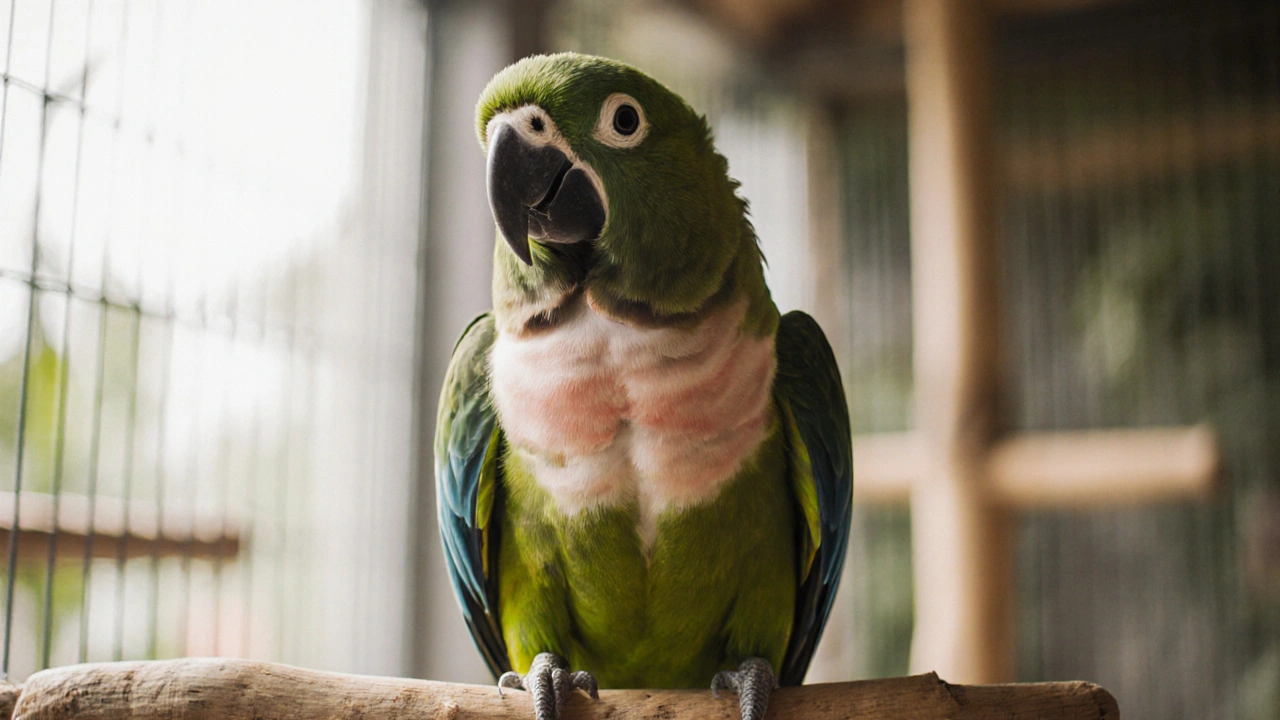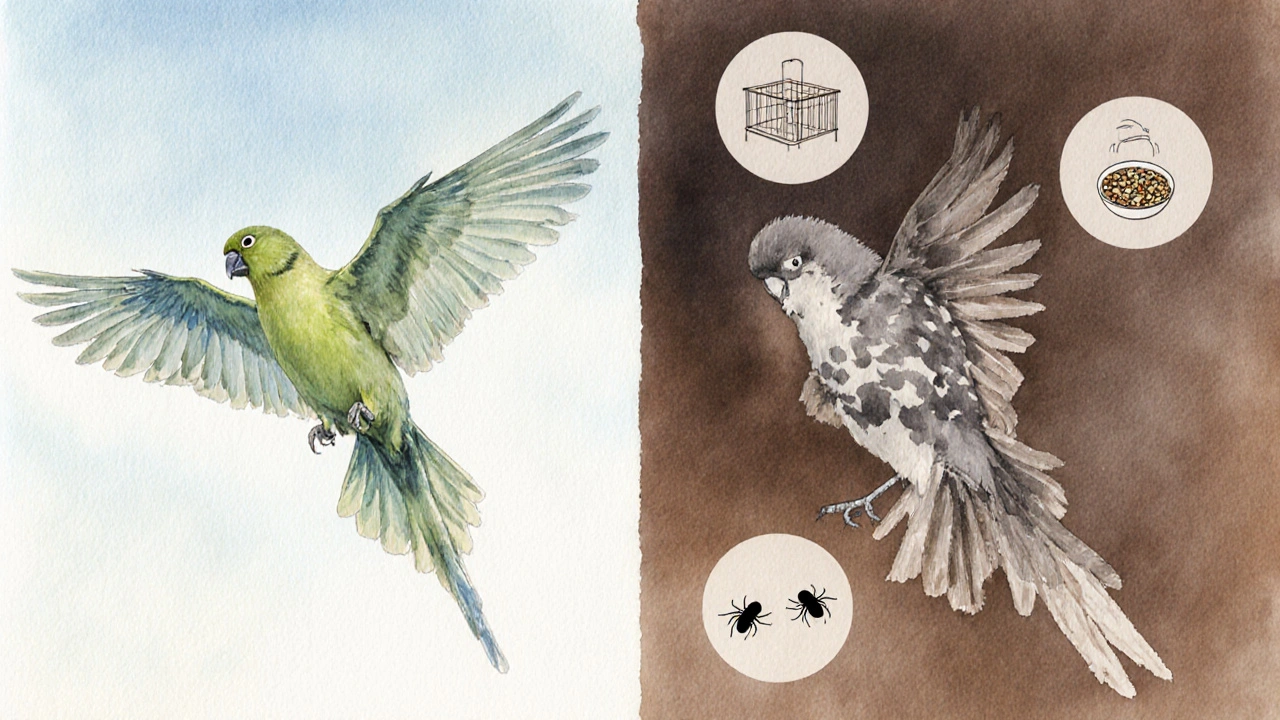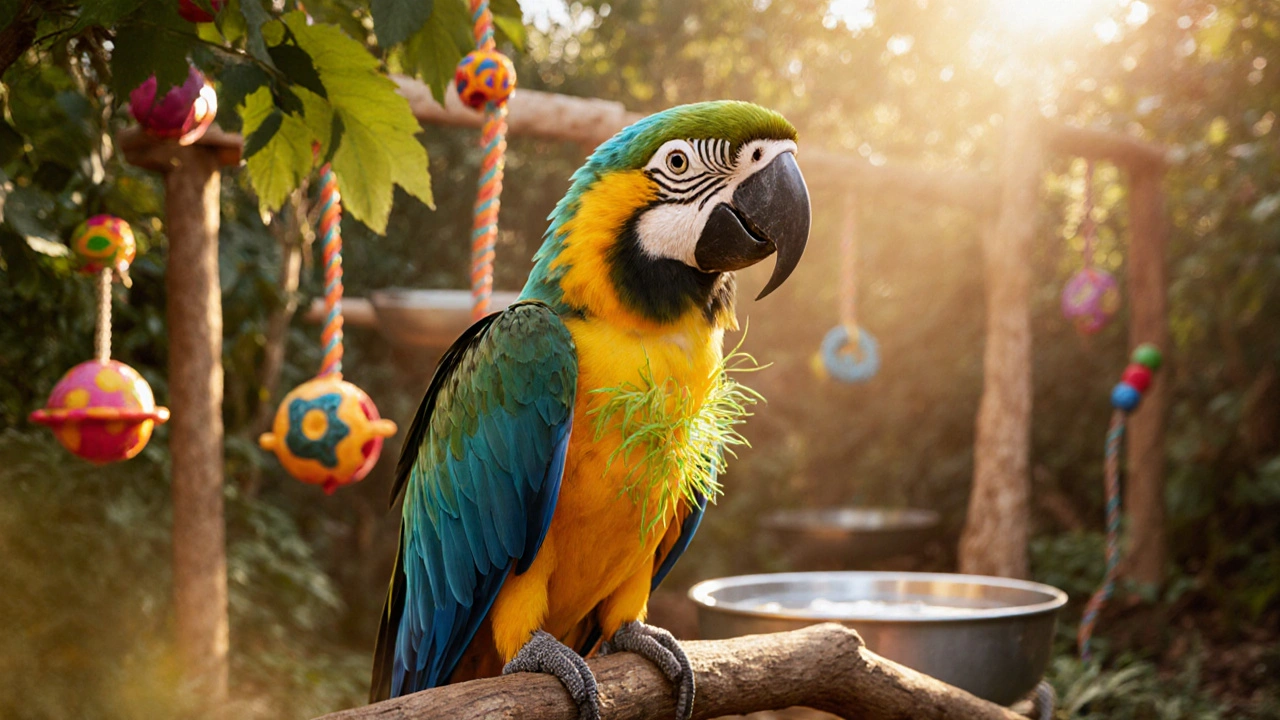Deplumation in Birds: Myths Debunked and Health Facts

Deplumation Diagnosis Checker
Answer the following questions to assess whether your bird may be experiencing deplumation or normal molting:
Answer the questions above to see if your bird may be experiencing deplumation.
Deplumation is a term that pops up in bird‑keeping forums, veterinary articles, and casual conversations about pet parrots and backyard songbirds. It describes the loss of feathers that goes beyond the normal, seasonal shedding known as molting. While many bird owners assume that any feather loss is harmless, the reality is far more nuanced. This guide separates fact from fiction, so you can spot the warning signs early and give your feathered friend the right care.
Understanding Deplumation vs. Molting
First, let’s clear up the basic definitions. Molting is a natural, cyclical process where birds replace old feathers with new ones. It usually follows a predictable pattern and doesn’t cause large bald patches. Deplumation, on the other hand, is abnormal feather loss that can be patchy, rapid, and sometimes permanent. It often signals an underlying health issue such as stress, nutritional deficiency, or disease.
Common Myths About Feather Loss
Bird enthusiasts have coined several explanations for why a bird might start losing feathers. Below is a quick rundown of the most popular myths, followed by the evidence‑based facts that debunk them.
Myth 1: Deplumation Is Just Another Form of Molting
Many owners assume that any feather shedding is simply a variation of molting. The truth is that Molting follows a regular schedule and occurs symmetrically across the body. Deplumation often appears as irregular, uneven gaps, sometimes concentrated on the chest, tail, or wings. If the loss occurs rapidly-more than a few feathers per day-or is accompanied by skin irritation, it’s a red flag that something else is at play.
Myth 2: Stress Alone Causes Severe Feather Loss
Stress certainly contributes to feather‑pulling behavior, especially in captive parrots that lack mental stimulation. However, stress is rarely the sole driver of severe deplumation. Studies on captive cockatiels show that when stress is paired with a protein‑deficient diet, the rate of feather loss can double. In most cases, stress acts as a catalyst that amplifies an existing nutritional or medical problem.

Myth 3: Poor Diet Is the Only Reason for Deplumation
While an imbalanced diet lacking essential amino acids, vitamins A and E, and minerals like calcium can weaken feather structure, it’s not the only culprit. Parasites, hormonal imbalances, and environmental toxins (e.g., heavy metals in contaminated water) can also lead to feather loss. A comprehensive health check should always include a dietary review, but also parasite screening and blood work to rule out other factors.
Myth 4: Parasites Always Cause Deplumation
External parasites such as Mange mites can cause itching and feather picking, yet not every bird with a parasite problem will develop major bald patches. In a survey of 120 pet parrots, only 22% with diagnosed mite infestations showed significant deplumation, suggesting that host resilience, genetics, and secondary infections play a role.
Myth 5: Lost Feathers Never Grow Back
Feather regrowth is possible if the underlying cause is addressed early. Once the stressor, nutritional gap, or disease is controlled, new feathers usually start to emerge within 4‑6 weeks. However, permanent feather loss can occur if the feather follicles are damaged beyond repair-often the case with chronic skin infections or prolonged toxin exposure.
How to Diagnose Deplumation
Diagnosing deplumation involves a systematic approach:
- Visual Inspection - Look for irregular gaps, broken or frayed feathers, and any signs of skin inflammation.
- History Review - Note recent changes in diet, environment, or social dynamics (new cage mates, breeding attempts, etc.).
- Physical Exam - An avian veterinarian will check for skin lesions, parasites, and feather quality.
- Laboratory Tests - Blood panels to assess vitamin A/E levels, hormone panels for thyroid or reproductive hormones, and fecal exams for internal parasites.
- Environmental Assessment - Test water for heavy metals, examine cage materials for toxic paints or plastics.
Only after ruling out normal molting can the diagnosis of deplumation be confirmed.

Management and Prevention Strategies
Once the root cause is identified, treatment typically follows three pillars: nutrition, environment, and health care.
- Nutrition: Offer a balanced diet that includes high‑quality pellet blend (minimum 30% protein), fresh vegetables rich in beta‑carotene (e.g., carrots, kale), and occasional nuts for essential fatty acids. Supplements of vitamin A and E can be added under veterinary guidance.
- Environmental Enrichment: Provide foraging toys, climbing structures, and regular out‑of‑cage time to reduce boredom‑related feather pulling.
- Stress Reduction: Keep the cage in a quiet, low‑traffic area, maintain a consistent daily routine, and avoid sudden changes in lighting or temperature.
- Parasite Control: Routine mite checks and quarterly fecal exams keep internal and external parasites in check.
- toxin Monitoring: Use filtered water, avoid non‑bird‑safe cleaning agents, and replace old plastic perches that may leach phthalates.
In severe cases, a short course of corticosteroids or antibiotics may be prescribed to address inflammation or secondary infections. Always follow the vet’s dosage instructions.
When to Seek Professional Help
If you notice any of the following, book an appointment promptly:
- Rapid feather loss (more than 5% of the body surface in a week).
- Bleeding or open wounds on the skin.
- Changes in appetite, weight loss, or lethargy.
- Visible parasites or crusty scabs.
- Repeated feather‑pulling despite enrichment and dietary changes.
Early intervention can prevent permanent follicle damage and improve the chances of full feather regrowth.
Quick Reference: Myth vs. Fact Table
| Myth | Fact |
|---|---|
| Deplumation is just a heavy molt. | Deplumation is irregular, often linked to health issues, while molting follows a predictable pattern. |
| Stress alone causes severe feather loss. | Stress can trigger feather‑pulling, but usually works with poor nutrition or disease. |
| Poor diet is the only cause. | Parasites, hormonal imbalances, and toxins can also lead to deplumation. |
| All birds with parasites lose feathers. | Only a subset develop significant feather loss; host factors matter. |
| Lost feathers never grow back. | Feathers can regrow if the underlying problem is treated early. |
Bottom Line
Feather loss can be a sign of a deeper issue, not just a cosmetic problem. By understanding the difference between normal molting and abnormal deplumation, debunking common myths, and taking proactive steps-balanced diet, enrichment, regular health checks-you give your bird the best chance for a full, healthy plumage.
Frequently Asked Questions
What is the first sign that a bird is experiencing deplumation?
The earliest indicator is an uneven patch of missing feathers, often on the chest or tail, accompanied by dull or broken feather shafts.
Can I treat deplumation at home without a vet?
Mild cases linked to diet or boredom can improve with better nutrition and enrichment, but any rapid or extensive feather loss should be examined by an avian veterinarian.
How long does it take for new feathers to grow back?
Once the cause is removed, new feathers usually start appearing within 4‑6 weeks, with full regrowth taking 2‑3 months.
Are certain bird species more prone to deplumation?
Parrots, especially cockatiels and macaws, are more commonly affected due to their social nature and tendency to develop feather‑pulling behaviors under stress.
Is there any supplement that can prevent feather loss?
A balanced supplement containing vitamins A, E, and zinc can support feather health, but it should only be used after a vet confirms a deficiency.
Maddie Wagner
October 9, 2025 AT 23:19Alright, let’s cut to the chase – if you see those odd bald patches on your feathered friend, don’t just assume it’s a “new look.” First, pull the bird into a well‑lit area and do a thorough visual inspection, checking for broken shafts, redness or scabs. Next, compare the pattern to a normal molt chart – molting is symmetrical, while deplumation is patchy and often rapid. Run a quick skin scrape or feather pull test to see if there’s any irritation or parasites lurking. Then, review any recent changes: new cage mates, diet tweaks, or even a shift in lighting can trigger stress‑induced feather pulling. If anything looks off, book an avian vet appointment pronto – early intervention can save follicles from permanent damage.
Remember, the sooner you act, the better the chances for healthy regrowth.
Kris cree9
October 13, 2025 AT 10:39Honestly, people who brush off severe feather loss as “just a phase” are doing a disservice to animals. It’s not cute to ignore a bird’s suffering, and anyone who thinks it’s okay to neglect proper vet care is missing the point. We have a responsibility to give these creatures the attention they deserve.
Paula Hines
October 16, 2025 AT 21:59Deplumation is not a simple cosmetic issue it is a physiological signal that something is amiss in the avian system. The process of feather loss is controlled by a complex hormonal cascade involving thyroid hormones and corticosterone levels. When stressors such as environmental changes or nutritional deficits disrupt this balance the bird may begin to shed feathers in an irregular fashion. The literature shows that deficiencies in vitamin A and E correlate strongly with the breakdown of keratin structures in feathers. Moreover recent studies have identified heavy metal exposure as a catalyst for follicular apoptosis. Parasites are often implicated but they are rarely the sole cause they act in concert with host immunity and diet quality. A thorough diagnostic workup therefore includes blood panels hormone assays and fecal examinations all performed by a qualified avian practitioner. Imaging of the integumentary system can reveal underlying infections that are not apparent on visual inspection. Treatment plans must be multifaceted addressing nutrition supplementation environmental enrichment and, when necessary, pharmacological intervention. The timing of intervention is critical because prolonged follicular damage can become irreversible leading to permanent bald spots. Owners should monitor their birds daily for subtle changes in behavior such as increased vocalization or reduced appetite as early warning signs. Providing a balanced pellet diet supplemented with fresh vegetables rich in beta carotene supports feather regeneration. Incorporating foraging toys reduces boredom which is a known trigger for feather‑pulling behaviors. Regular water quality testing ensures that no toxic substances are being ingested inadvertently. Finally, establishing a consistent routine minimizes stress and promotes overall health in pet birds. By adhering to these evidence‑based practices owners can dramatically improve outcomes for birds suffering from deplumation.
John Babko
October 20, 2025 AT 09:19Indeed, the multifaceted approach you outline, from hormonal assessments, to environmental enrichment, and precise dietary supplementation, is essential, and I would add that regular feather quality scoring, combined with periodic veterinary check‑ups, creates a robust preventive strategy.
Dennis Owiti
October 23, 2025 AT 20:39I totally get how worrying it can be when your bird starts losing feathers, it’s super stressful not knowing if it’s something serious or just a normal molt, so taking those first steps you mentioned, like checking for irritations and reviewing diet, can really put your mind at ease.
Justin Durden
October 27, 2025 AT 07:59Just stay calm and monitor daily.
Sally Murray
October 30, 2025 AT 19:19From a veterinary perspective, the differential diagnosis of abnormal feather loss must systematically exclude physiologic molting, nutritional deficiencies, parasitic infestations, and endocrine disorders before confirming deplumation as a primary pathology.
Bridgett Hart
November 3, 2025 AT 06:39While your summary is accurate it omits the critical role of toxin screening which can be the hidden factor behind many cases of irreversible follicular damage.
Sean Lee
November 6, 2025 AT 17:59The pathophysiology of deplumation can be conceptualized as a dysregulation of the integumentary homeostasis axis, wherein perturbations in the hypothalamic‑pituitary‑adrenal (HPA) feedback loop precipitate keratinocyte apoptosis and subsequent feather extrusion.
Michael Christian
November 10, 2025 AT 05:19Sounds complicated but basically keep the bird happy, fed well and see a vet if things get worse.
Chelsea Hackbarth
November 13, 2025 AT 16:39Did you know that a 30% increase in dietary vitamin A can accelerate feather regrowth by up to two weeks? 🦜💡
Adam Shooter
November 17, 2025 AT 03:59Statistical meta‑analysis of avian deplumation case series reveals a significant correlation (p < 0.01) between chronic corticosterone elevation and patchy feather loss, underscoring the necessity for endocrine profiling in refractory presentations.
Anupama Pasricha
November 18, 2025 AT 23:19It’s great to see the community sharing such thorough information; keeping an eye on diet, environment, and regular health checks will definitely give birds the best chance at full recovery.